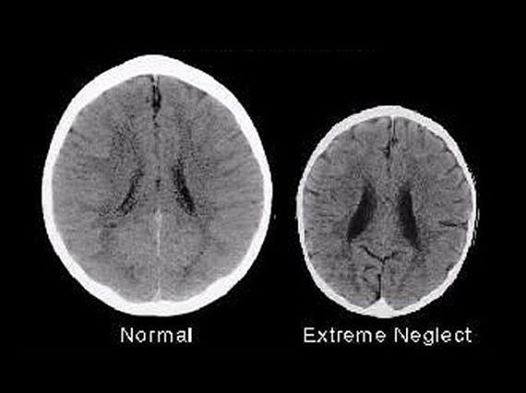
Brain imaging technologies allow researchers to look inside the brain to see the effects of injuries, diseases, drugs, chemicals — and parental neglect. These two scans both belong to three-year-olds, so why is one so much bigger? Because one was loved by their parents and the other was neglected.
The chilling images reveal that the left brain, which belongs to a typical three-year-old, is significantly larger and contains fewer spots and dark “fuzzy” areas than the right brain, which belongs to that of a three-year-old who has suffered extreme neglect.
Children neglect impacts brain size
Neurologists say that these images provide more evidence that how children are treated in their early years is essential for their emotional development and for determining their brain size. Experts say that the sizeable difference in the two brains is primarily caused by the difference in how each child was treated by their mothers.
While at first glance, the images might indicate that the child with the right brain might have suffered a serious accident or illness, neurologists said that the truth is that the child with the shrunken brain was neglected and abused by their mother. The child with the larger and more fully developed brain was raised in a loving, supportive home and was looked after by their mother.
Impact is cognitive, social, and emotional
According to researchers, the image of the brain scan on the right shows that the child lacks some of the most fundamental areas in the image of the brain scan on the left. They say that the child on the left with the larger brain will be more intelligent and more likely to develop the social ability to empathize with others than the child on the right.
On the other hand, the child with the smaller brain on the right will be more likely to become addicted to drugs, be involved in violent crimes, be unemployed, and be dependent on government benefits in the future. Furthermore, the child with the shrunken brain is significantly more likely to develop mental and other serious health-related problems.
Professor Allan Schore from the University of California, Los Angeles (UCLA) said babies rely on a strong bond with their mothers for healthy brain development in their first two years. “The development of cerebral circuits depends on it,” he said, adding that because 80 percent of brain cells grow in the first two years of life, problems in that development can affect people for the rest of their lives.
Vicious circle requiring early intervention
Researchers say the process of childhood neglect is a vicious cycle because the parents of neglected children were also neglected by their parents and do not have a fully developed brain. However, past research has shown that the cycle can be broken if there is early intervention and families are supported.
“Early intervention” has been tried in parts of the US for more than 15 years. It consists of ensuring that mothers identified as “at risk” of neglecting their babies are given regular visits (at least once every week) by a nurse who instructs them on how to care for the newborn child. Data from the city of Elmira in New York State, where such programs have been in place longest, show that children whose mothers had received those visits did much better than children from a comparable background whose mothers were not part of the program: they had, for instance, 50 percent fewer arrests, 80 percent fewer convictions, and a significantly lower rate of drug abuse.
.

